Naas Golf Club was established in 1896 as a nine-hole course. It is one of the oldest clubs in Ireland and has just celebrated 125 years in exixtence in 2021. Originally known as the County Kildare Club it has expanded from a twenty member club to today’s membership of eleven hundred.
When the club affiliated to the GUI in 1907, the nine-hole course was located at the Decoy, just outside Naas. It was to move three more times before finally settling at Kerdiffstown in 1941. In the 1980’s it expanded to an eighteen-hole golf course with the clubhouse overlooking the 1st and 18th holes and the Wicklow Mountains.
David Behan has been a course manager for twenty five years, eighteen of which have been at Naas. He began working there in July 2003 after working previously at Killeen Golf Club and Navan Golf Club. He was president of the Golf Course Superintendents Association of Ireland (GCSAI and now called the Association of Turfgrass Professionals Ireland) from 2007 – 2009. David is always keen to learn and in 2015 he received a Diploma in Integrated Pest management from University College Dublin (UCD). This qualification means that he can be a legal advisor on Integrated Pest Management in Ireland. David also studied Sportsturf Management at the National Botanic Gardens in Glasnevin.
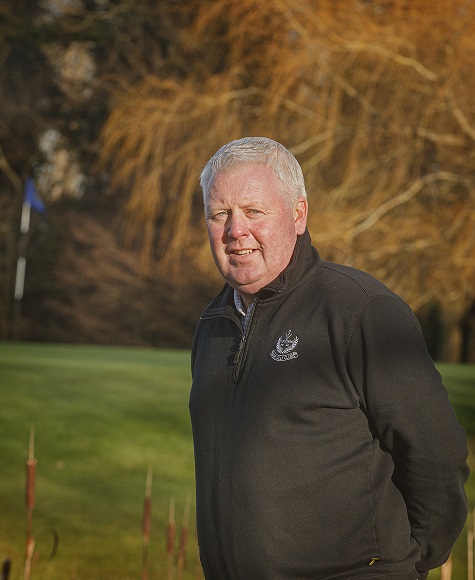
David Behan, the Course Manager at Naas Golf Club
Back in 2000, seven new greens were constructed. There were already eleven poa greens (including a putting green) in existence. Dave realised that in order to have the same putting consistency throughout the course, the best strategy was to allow the native poa greens to become the dominant sward. As we all know too well, there is some pain in realising this but once you commit to the idea there is no going back. “It took over ten years for the greens to convert” said David.
During 2015 and 2016 nine holes (2 – 10) were redeveloped at a cost of €400,000. During this redevelopment, which saw the redesign of these holes, temporary greens and tee boxes were put in place. The holes were designed by Jeff Lynch and the late Paul O’Brien of re-Golf Design. One feature that was introduced to some of these holes was a new style of grass bunkers that included a type of revetted vertical grass embankment. I have never come across this feature before on a golf course. It will be interesting to see if it will catch on to other golf clubs. The newly designed nine holes have greatly improved the layout of the course. David hopes to see Naas Golf Club develop into an eighteen hole ‘finished’ course.
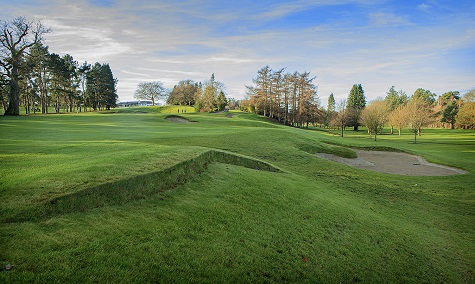
The 12th hole showing one of the new types of grass bunkers that were recently introduced to the course
David has worked with various agronomists and agronomy companies over the years and has seen different styles of management from each. In conjunction with his current agronomist, they have come up with a programme of maintaining the native (and hard wearing) poa greens in a sustainable way. This is a continuous learning curve for David. David feels that, with many of the major tournaments in Ireland being played on predominantly poa greens, there should be more support from governing golf organisations to encourage the growing and maintenance of native grasses. “Poa is a natural predator, so why compete against something that is native to the environment. It’s hard to compete with nature, we try work with it as best we can,” said David.
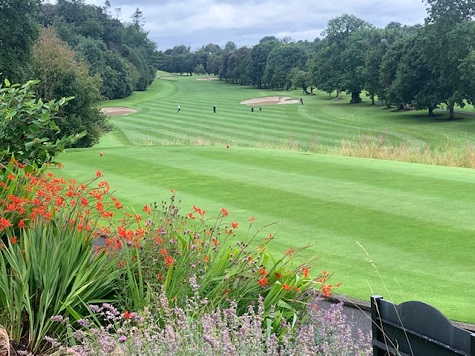
A view of the 13th hole. Photo David Behan
David believes in best practice for plant health. He achieves this by properly managed fertiliser inputs on the greens as well as using growth regulators and plant protection products in a managed way. “I get my timing of applications from up to date data such as soil temperature, organic matter levels, humidity, temperature and Growth Degree Days. All this information gives me an indication for the best time to apply products”, said David. With regard to disease control, David applies fungicides on a ten to fourteen day preventative programme during high disease outbreak periods. However, as each year passes, fewer chemicals are becoming available to the greenkeeper to treat against disease, due to EU regulations. Those chemicals that are legally available have less efficacy than the ‘old reliables’ that have since been removed from the market. “There is an expectation from golfers that diseases can be controlled in the same way as they were a few years ago. They expect more from less products. Because our choices of chemicals are limited this is not always the case. I think golfers expectations are higher than what is happening in the real world. Getting this message across and educating the golfer on this topic is a challenge in itself ” said David. “I thought that by 2020 we would have no chemicals available to us but, thankfully, there are still four types on the market” he continued. David believes that having a healthy sward will be an advantage when it comes to disease supression “It may take a little longer to control the disease but if you have healthy grass your turf will always recover in the end” said David.
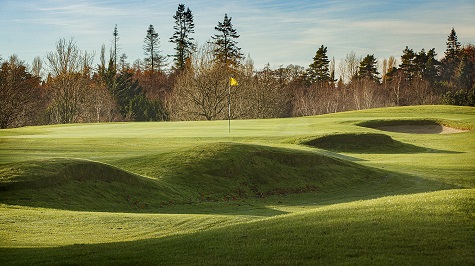
The 7th green features some grass bunkers
Staff
David has five full time staff, which includes a mechanic and also some seasonal staff. He used to have eight but budget constraints within the club has reduced this number. David hopes to get back to eight staff in the future. The staff who operate chainsaws and carry out spraying operations are legally trained to do these jobs. David Garland is David’s assistant. He has seen many changes over his twenty two years working at Naas.
Some of the staff are keen golfers, which David encourages. “If you play the game of golf it invariably follows that you think like a golfer when it comes to course maintenance. You know what is expected. It comes natural to you” said David who once had ambitions of becoming a professional golfer himself, but when he got a summer job on a golf course he then developed a love for greenkeeping.
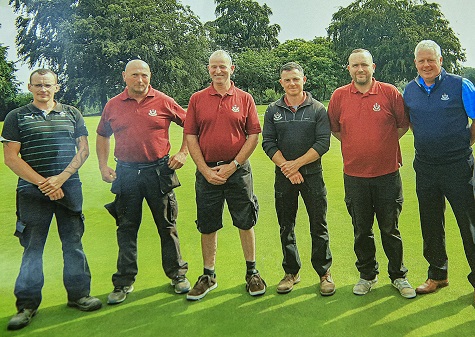
The greenkeeping staff from left: Andrew Brennan, Alan Rawlins, Tom Maxwell, David Garland, John O’Brien, David Behan
Covid
David and his team managed to get in some extra projects around the course during the lockdowns of 2020 and 2021. Projects included introducing wild flowers to the 3rd hole, creating an azalea and rhododendron planting bed, clearing some of the woodlands, bulb planting, upgrading the bunker complexes on the 12th hole and even the building of a new practice green. However having the course closed did not sit well for David. “I found it very uncomfortable having no golfers playing the course. It was a very strange feeling not being able to prepare the course for golfers to play on. Even though we still maintained the course and were able to get in some extra projects. However, adding new features to the course was great and the members appreciated them too”, said David. He also believes that a golf course is a safe place to play and is now accepted as an important social outlet.
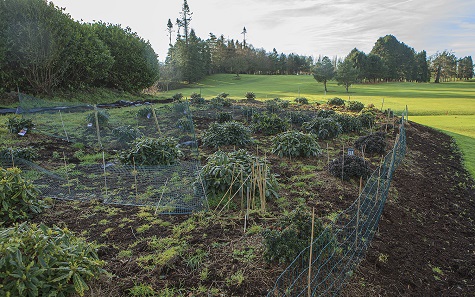
The new azalea and rhododendron planting bed that was added during the 2021 lockdown
Environment
Talking to David, one would think that he is more of an environmentalist than a greenkeeper. Perhaps he is, (he has three beehives at his home) but either way, the role of greenkeeper and nature conservationist work hand in hand. This is very evident at Naas. The areas of the course that are set aside for wild flora and woodland are huge. There are approximately twenty five acres of unmaintained woodland alone and forty acres of maintained rough (without fertiliser inputs). In fact the only areas on the course that get nutrient inputs are the greens, tees and fairways which make up around thirty five acres.
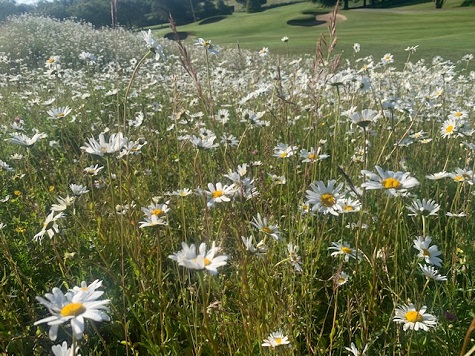
Wild flora add a lot of colour to the course during the summer. Photo David Behan
In late summer around two acres of high grass growth is cut down and gathered up. This encourages wild flora, which thrive best in hungry ground. Because of this practise, a natural colonisation of wild flora has occurred. Mindful of these wild areas around the course, David uses anti drift nozzles when controling weeds on tees, surrounds and fairways so as to reduce spray drift contaminating the wild flowers.
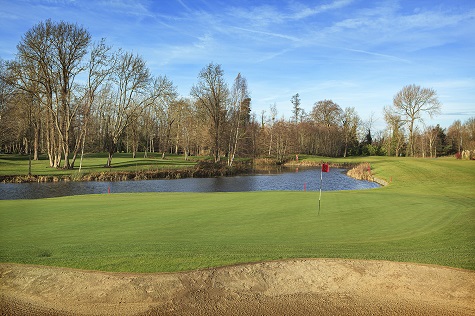
The 17th hole, a tough par three
Several years ago the club invested in a water recycling facility which avoids contaminated water run off into the drains and water courses. The club is very consciences about their waste management program. This involves using separate bins around the clubhouse and tee boxes.
Maintaining the course to the highest standard possible is part of David’s daily work schedule. However, David believes that being a course manager is not just about maintaining a golf course. “I believe that the golf course should be treated like a premium product. This product is what the golfer is buying into when they become a member so it must be as near perfect as possible for them, not just from a maintenance point of view but also from a design aspect as well”, said David. David is a man that always looks ahead to the next project. His ambition is to have an eighteen hole course at Naas that offers a fair challenge to all golfers. “At the end of the day golf is a just a form of recreation for our members but it is also our profession and we are very passionate in what we do. The golf course is a premium product for golfers. In order to keep up with their expectations, continouos investment needs to be put into the course. This is so important” said David. Having a complete course would be David’s ideal legacy. He is well on his way to achieving this.
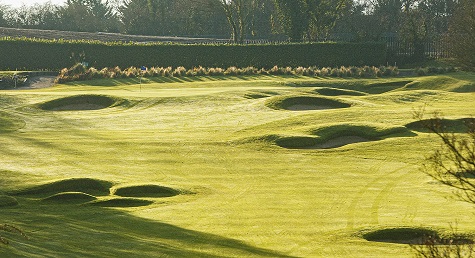
The 9th hole is guarded with plenty of bunkers